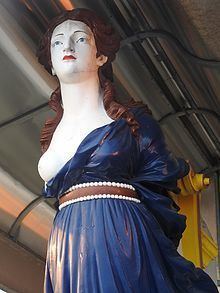Name HMS Arethusa Laid down 30 March 1846 Reclassified Training ship in 1874 Launched 20 June 1849 | Ordered 19 February 1844 Completed 20 March 1850 Construction started 30 March 1846 Displacement 3.364 million kg | |
 | ||
Fate Sold on 2 August 1933Broken up in 1934 | ||
HMS Arethusa was a 50-gun fourth-rate frigate of the Royal Navy launched in 1849. She was fitted with screw propulsion in 1861 and became a training ship in 1874 and finally scrapped in 1933 at Woolwich. Arethusa was an all-wooden construction, and the last major ship of the Royal Navy to enter an engagement under sail power only (1854, during the Crimean War).
Contents
The ship's figurehead, originally carved by the Hellyer family, has been preserved and remains on exhibit at Upnor.
Service
Arethusa saw service during the Crimean War, with battles at Odessa and Sevastopol. At the time of the battle in 1854, was Capt. William Robert Mends.
Arethusa Venture Centre
Once decommissioned, in 1874, the ship was passed from the Royal Navy to a charity called Shaftesbury Homes who moored her at Greenhithe. Shaftesbury Homes provided refuge and taught maritime skills to children who had been sleeping rough on the streets of London. It trained those young boys for a career in the Royal Navy or Merchant Navy. In 1933 the wooden frigate was no longer viable, and was replaced by the steel hulled Peking (ship) which was moored at Upnor on the Medway, and renamed Arethusa. The frigate was broken up and the figurehead was taken to the onshore base at Upnor. The second Arethusa was sold on in 1974 and the onshore base was reconfigured as the Arethusa Venture Centre. It provides residential school trips and educational visits for young people throughout the UK. It also offers outdoor challenges and adventures, to aid confidence and self-esteem in young people.
